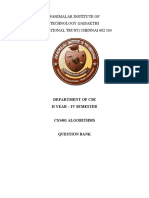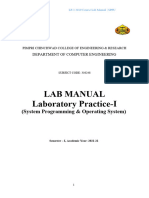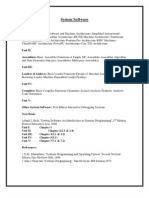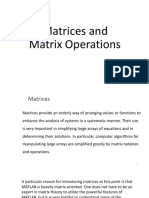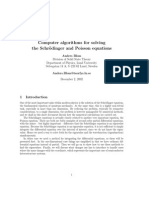Analysis of Recursive Algorithms
Uploaded by
007wasrAnalysis of Recursive Algorithms
Uploaded by
007wasrIntroduction to analysis of algorithms
Analysis of Recursive Algorithms
Dr. Abeer Hamdy
Decide on a parameter indicating an inputs size.
Identify the algorithms basic operation.
Check whether the number of times the basic op. is
executed may vary on different inputs of the same
size. (If it may, the worst, average, and best cases
must be investigated separately.)
Set up a recurrence relation with an appropriate
initial condition expressing the number of times the
basic op. is executed.
Solve the recurrence equation.
Plan of Analysis of Recursive Algorithms
Input Size: n
Basic operation: multiplication
Recurrence relation: T(n)=T(n-1)+1 for n>0, T(0)=0
Example 1: Recursive evaluation of n!
Solving recurrence equations
It means finding a closed form solution to the
recurrence. i.e. Explicit formula expresses
T(n) in terms of n only.
Methods of solving recurrence:
Iterative substitution.
The master method.
Recursion trees.
Guess-and-test.
Iterative Substitution
In the iterative substitution, or plug-and-chug,
technique, we iteratively apply the recurrence
equation to itself and see if we can find a pattern:
Recurrence relation: T(n) = T(n-1)+1 for n>0 , M(0)=0
T(n) = T(n-2) +2 as ,T(n-1) = T(n-2)+1
T(n) = T(n-3) +3 as, T(n-2)= T(n-3) +1
..
T(n) = T(n-i) +i
The base case occurs when i=n
T(n) = T(n-n) +n = 0+n
= n
Iterative Substitution
Given the following recurrence relation:
> +
<
=
2 if ) 2 / ( 2
2 if
) (
n bn n T
n b
n T
Find a closed form for T(n) using iterative
substitution?
Iterative Substitution
Base case occurs when n= 2
i
, i=logn
So, T(n) = nT(1) + bn logn = bn + bnlogn = O(nlogn)
ibn n T
bn n T
bn n T
bn n T
bn n b n T
bn n T n T
i i
+ =
=
+ =
+ =
+ =
+ + =
+ =
) 2 / ( 2
...
4 ) 2 / ( 2
3 ) 2 / ( 2
2 ) 2 / ( 2
)) 2 / ( )) 2 / ( 2 ( 2
) 2 / ( 2 ) (
4 4
3 3
2 2
2
Master Theorem
Many divide-and-conquer recurrence equations have the form:
The Master Theorem:
> +
<
=
d n n f b n aT
d n c
n T
if ) ( ) / (
if
) (
. 1 some for ) ( ) / ( provided
)), ( ( is ) ( then ), ( is ) ( if 3.
) log ( is ) ( then ), ( is ) ( if 2.
) ( is ) ( then ), ( is ) ( if 1.
log
log log
log log
< s
O O
O O
O
+
o o
c
c
n f b n af
n f n T n n f
n n n T n n f
n n T n O n f
a
a a
a a
b
b b
b b
Master Theorem Examples
Example1 :
Solution: log
b
a=2, so case 1 says T(n) is O(n
2
).
Example2:
Solution: : log
b
a=1, so case 2 says T(n) is O(n log
2
n).
Example3:
Solution: log
b
a=0, so case 3 says T(n) is O(n log
n).
n n T n T + = ) 2 / ( 4 ) (
n n n T n T log ) 2 / ( 2 ) ( + =
n n n T n T log ) 3 / ( ) ( + =
Master Theorem Examples
Example4 :
Solution: log
b
a=0, so case 2 says T(n) is O(log n).
Example5:
Solution: log
b
a=2, so case 3 says T(n) is O(n
3
).
Example6:
Solution: log
b
a=3, so case 1 says T(n) is O(n
3
).
1 ) 2 / ( ) ( + = n T n T
3
) 3 / ( 9 ) ( n n T n T + =
2
) 2 / ( 8 ) ( n n T n T + =
Guess-and-Test Method
In the guess-and-test method, we guess a closed form solution
and then try to prove it is true by induction.
Example: Consider the following recurrence:
Guess1: T(n) < cn log n.
Wrong guess: we cannot make this last line be less than cn log n
> +
<
=
2 if log ) 2 / ( 2
2 if
) (
n n bn n T
n b
n T
n bn cn n cn
n bn n cn
n bn n n c
n bn n T n T
log log
log ) 2 log (log
log )) 2 / log( ) 2 / ( ( 2
log ) 2 / ( 2 ) (
+ =
+ =
+ =
+ =
Guess-and-Test Method
Guess 2: T(n) < cn log
2
n.
if c>b
So, T(n) is O(n log
2
n).
In general, to use this method, you need to have a good guess
and you need to be good at induction proofs.
n cn
n bn cn n cn n cn
n bn n cn
n bn n n c
n bn n T n T
2
2
2
2
log
log log 2 log
log ) 2 log (log
log )) 2 / ( log ) 2 / ( ( 2
log ) 2 / ( 2 ) (
s
+ + =
+ =
+ =
+ =
You might also like
- Hourglass Workout Program by Luisagiuliet 276% (21)Hourglass Workout Program by Luisagiuliet 251 pages
- Read People Like A Book by Patrick King-Edited58% (81)Read People Like A Book by Patrick King-Edited12 pages
- Livingood, Blake - Livingood Daily Your 21-Day Guide To Experience Real Health77% (13)Livingood, Blake - Livingood Daily Your 21-Day Guide To Experience Real Health260 pages
- Donald Trump & Jeffrey Epstein Rape Lawsuit and Affidavits83% (1016)Donald Trump & Jeffrey Epstein Rape Lawsuit and Affidavits13 pages
- The 36 Questions That Lead To Love - The New York Times94% (34)The 36 Questions That Lead To Love - The New York Times3 pages
- The 36 Questions That Lead To Love - The New York Times95% (21)The 36 Questions That Lead To Love - The New York Times3 pages
- 14 Easiest & Hardest Muscles To Build (Ranked With Solutions)100% (8)14 Easiest & Hardest Muscles To Build (Ranked With Solutions)27 pages
- Jeffrey Epstein39s Little Black Book Unredacted PDF75% (12)Jeffrey Epstein39s Little Black Book Unredacted PDF95 pages
- The 4 Hour Workweek, Expanded and Updated by Timothy Ferriss - Excerpt23% (954)The 4 Hour Workweek, Expanded and Updated by Timothy Ferriss - Excerpt38 pages
- Master Theorem - Master Theorem Examples - Gate VidyalayNo ratings yetMaster Theorem - Master Theorem Examples - Gate Vidyalay11 pages
- Computational Problem Solving: Chapter 1, Sections 1.5-1.7100% (1)Computational Problem Solving: Chapter 1, Sections 1.5-1.739 pages
- Decimal Binary C Programming Using SwitchNo ratings yetDecimal Binary C Programming Using Switch10 pages
- Important Terms: Chapter 5 - Graph and Tree Data Structures Data Structures and AlgorithmNo ratings yetImportant Terms: Chapter 5 - Graph and Tree Data Structures Data Structures and Algorithm20 pages
- Solution Manual for Introduction to the Design and Analysis of Algorithms, 3/E 3rd Edition Anany Levitindownload100% (10)Solution Manual for Introduction to the Design and Analysis of Algorithms, 3/E 3rd Edition Anany Levitindownload59 pages
- Asymptotic Notation, Review of Functions & Summations100% (1)Asymptotic Notation, Review of Functions & Summations45 pages
- 1 CS202 Computer Organisation Architecture - Model QPNo ratings yet1 CS202 Computer Organisation Architecture - Model QP3 pages
- Data Structures Using C and C++ - Y. Langsam, M. Augenstein and A. M. TenenbaumNo ratings yetData Structures Using C and C++ - Y. Langsam, M. Augenstein and A. M. Tenenbaum99 pages
- Lecture# 12-Recursive and Iterative Algorithms100% (1)Lecture# 12-Recursive and Iterative Algorithms17 pages
- NITW-PSCP Minor-1 09-09-2019-2-Answers PDFNo ratings yetNITW-PSCP Minor-1 09-09-2019-2-Answers PDF6 pages
- 16 String Matching - Naive String Algorithm100% (1)16 String Matching - Naive String Algorithm9 pages
- Numerical Analysis - Sivarnamakrishna Das, C. Vijayakumari First, 2014 -Compressed100% (1)Numerical Analysis - Sivarnamakrishna Das, C. Vijayakumari First, 2014 -Compressed385 pages
- CS6503 Theory of Computation Question Paper Nov Dec 2017No ratings yetCS6503 Theory of Computation Question Paper Nov Dec 20173 pages
- Rabin-Karp Algorithm For Pattern Searching: ExamplesNo ratings yetRabin-Karp Algorithm For Pattern Searching: Examples5 pages
- Numerical Analysis Course Outline OBE BasedNo ratings yetNumerical Analysis Course Outline OBE Based3 pages
- Model Cat 1 Question Paper: School of Advanced SciencesNo ratings yetModel Cat 1 Question Paper: School of Advanced Sciences9 pages
- Spring End Sem Data Structure Question 2012-13No ratings yetSpring End Sem Data Structure Question 2012-132 pages
- Algorithms . Recurrences: Dr. Issam Alhadid Modification Date 25/2/2019No ratings yetAlgorithms . Recurrences: Dr. Issam Alhadid Modification Date 25/2/201925 pages
- 4 Substitution Method and Master TheoremNo ratings yet4 Substitution Method and Master Theorem36 pages
- 10+2 Level Mathematics For All Exams GMAT, GRE, CAT, SAT, ACT, IIT JEE, WBJEE, ISI, CMI, RMO, INMO, KVPY Etc.From Everand10+2 Level Mathematics For All Exams GMAT, GRE, CAT, SAT, ACT, IIT JEE, WBJEE, ISI, CMI, RMO, INMO, KVPY Etc.No ratings yet
- Acy 2013 - 2014 - V 13 - 12 May 2014 - AfNo ratings yetAcy 2013 - 2014 - V 13 - 12 May 2014 - Af12 pages
- 13CSCI01I: Analysis of Algorithms Assignment #1: Assigned: Wednesday 23/10/2013 Deadline: Thursday 31/10/2013No ratings yet13CSCI01I: Analysis of Algorithms Assignment #1: Assigned: Wednesday 23/10/2013 Deadline: Thursday 31/10/20135 pages
- Phase 4: Implementation Deadline: Week 12 Weight: 35% of The Project WeightNo ratings yetPhase 4: Implementation Deadline: Week 12 Weight: 35% of The Project Weight1 page
- Computer Algorithms For Solving The SCHR Odinger and Poisson EquationsNo ratings yetComputer Algorithms For Solving The SCHR Odinger and Poisson Equations9 pages
- Learner Guide Cambridge International AsNo ratings yetLearner Guide Cambridge International As37 pages
- Ph.D. Course Work Pre-Ph.D. Examination Syllabus: Department of Mathematics, K L UniversityNo ratings yetPh.D. Course Work Pre-Ph.D. Examination Syllabus: Department of Mathematics, K L University54 pages
- Mutually Exclusive Events - Examples With SolutionsNo ratings yetMutually Exclusive Events - Examples With Solutions5 pages













































